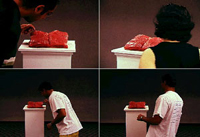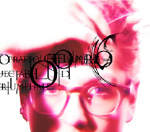Difference between revisions of "Projects"
| Line 3: | Line 3: | ||
[[Image:Metbook.jpg]] | [[Image:Metbook.jpg]] | ||
| + | |||
A project that provokes users' senses of their visceral responses. A time-based (that is, decaying) slab of meat, constructed as a book, is embedded with various sensors that cause the meat to react and quiver as the viewer approaches it. The reanimated flesh also responds with other movements and sound when users touch it. The next stage of development includes artificial intelligence and explores notions of generative art. | A project that provokes users' senses of their visceral responses. A time-based (that is, decaying) slab of meat, constructed as a book, is embedded with various sensors that cause the meat to react and quiver as the viewer approaches it. The reanimated flesh also responds with other movements and sound when users touch it. The next stage of development includes artificial intelligence and explores notions of generative art. | ||
Revision as of 06:57, 26 July 2006
MeatBook
A project that provokes users' senses of their visceral responses. A time-based (that is, decaying) slab of meat, constructed as a book, is embedded with various sensors that cause the meat to react and quiver as the viewer approaches it. The reanimated flesh also responds with other movements and sound when users touch it. The next stage of development includes artificial intelligence and explores notions of generative art.
Biomorphic Type™
BioMorphic Typography is Gromala's term for a family of fonts that respond, in real-time, to a user's changing physical states, as measured by a biofeedback device. Rather than one typeface, it is a postmodern pastiche of many different fonts that are continually morphing. So, for example, the font "throbs" as the user's/writer's heart beats, expands as the user breathes, and "spikes" according to galvanic skin response. In this way, users become aware of their autonomic states -- physiological states that usually remain under our conscious awareness. This project is part of a larger initiative, Design for the Senses. The goal is to develop new approaches to experiential design that focus on the senses and the phenomenological history of the body.

